The Story of Jim
Jim is staring into the slow patterns swirling in his coffee, feeling the wheels of his mind driving him full of motivation. These are the mornings that he lives for, when he is presented with a challenge that will demand everything from him.
Jim is a marketing manager, and is at the office early. He knows that today is going to be heavy.
Jim has a marketing presentation today and right now has nothing. Up until now, he has been running around removing obstacles for his younger team members, standing in to help them bounce around ideas, and offering guidance on their problems. And the team has come up with some really strong ideas that he believes in.
Now it is up to Jim to present these ideas from an angle that lets others see their merits. Let's see how Jim manages.
What Jim Doesn't Know
Shortly Jim will make his daily todo list, like he would with other day planning software—however he doesn't know that:
- He will face mental resistance when beginning to outline his marketing presentation.
- He will be interrupted with a high priority E-mail from another team, asking for some additional information they need to continue their project.
- His boss will hit him with an unexpected meeting with only 15 minutes warning.
- He will find himself distracted helping the Cornell division with their product results.
You will see how Jim handles these common occurrences using Watership Planner's day planner software capabilities. You will see how time mapping will readjust Jim's tasks as a visual timeline to stay up to the minute with Jim's agenda.
Coming Up With a Schedule to Start With

First thing Jim does is take 5 minutes to jot down what he needs to get done. He lists everything that needs to happen for him to be prepared for the meeting. He has to keep a good pace because he also has an appointment at 11am.
To enter items, Jim types them into the Task List, using Enter after each task to list them out like you would a grocery list in Notepad:

OK, nothing exciting yet, but Jim now has a todo list of things he needs to get finished for the day:

Since Jim is in the Day Tab these todos are associated with the selected day.
Now Jim also wants to show that a group of tasks are associated with a project. To do this Jim selects multiple tasks by holding down Shift to select a range, or with Ctrl to toggle the selection of an item. When multiple items are selected, any changes made to a column will apply to all the selected tasks. Here Jim has selected a group of tasks:

Since all the selected tasks are for the marketing presentation, he sets them all at once. If he needed to add a new project here, he could simply type it out, using \ to separate folders:
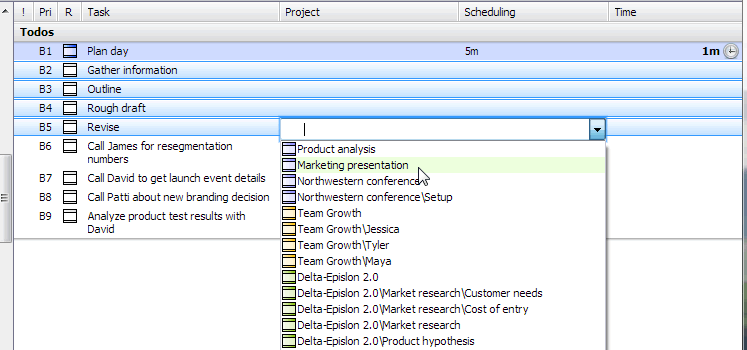
Now they have the same color as the project's associated role—that would be the "marketer" role. Everything is connected in Watership Planner, which helps Jim figure out later in what areas his time went. By task. By project. By role. By life area.
When tasks are associated with a project, they also appear in the Projects Tab which helps manage larger lists that can make up years of work. The tools in the Projects Tab are designed for evaluating and organizing entire paths of action, and selecting the most efficient path of action via ROI Prioritization. The Day Tab is about keeping you focused on the most important task at the moment while navigating the day to day challenges faced when trying to stay concentrated.
For tasks that aren't associated with a project, Jim can associate the task with a role. This is useful so he can color code his agenda, and for viewing reports of where his time went.
Jim double clicks the role column to bring down the list of his roles:
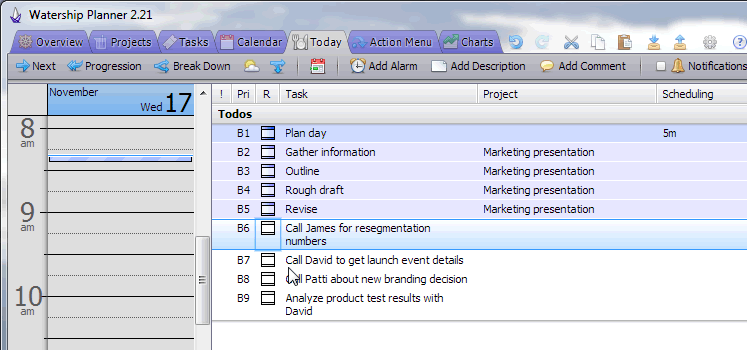
He can click to select a role, or begin typing to auto complete the role he wants to select, or type in a new role that will bring up a window so he can customize the color. Jim selects the "manager" role:
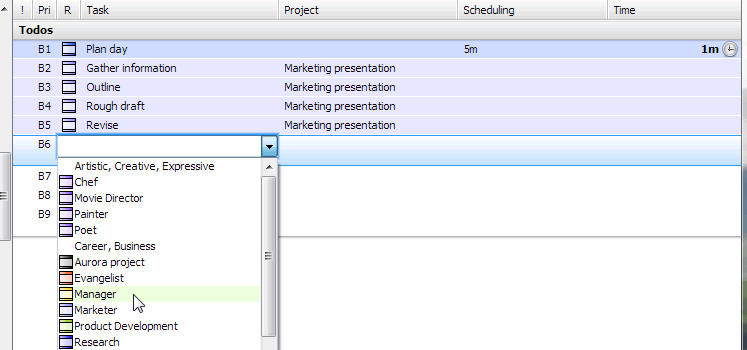
Turning the Todo List into a Schedule
Now that Jim has the tasks color coded by role, he wants to assign them estimates so that he can visualize what his day will look like. When you give tasks estimates they are mapped out for you automatically as a visual timeline in the Schedule View. Jim begins to type an estimate into the Scheduling Column, which responds like the other columns with suggestions:

Now with new estimates, the Schedule View shows the predicted schedule forecast. Like a GPS, it will recalculate itself when things go over or under their estimates, or when the schedule changes priorities, or whenever any change happens that could potentially change the schedule.
As soon as Jim finishes typing in 30m into the Scheduling Column, Time Mapping detects the change and updates the Schedule View:

The "gather information" task is now "mapped" onto Jim's schedule as a block of 30 minutes, after the blue sliver that represents the 5m "plan day" task. Filling out the rest of the estimates, Jim can see when everything is estimated to finish with a more complete map of his time:
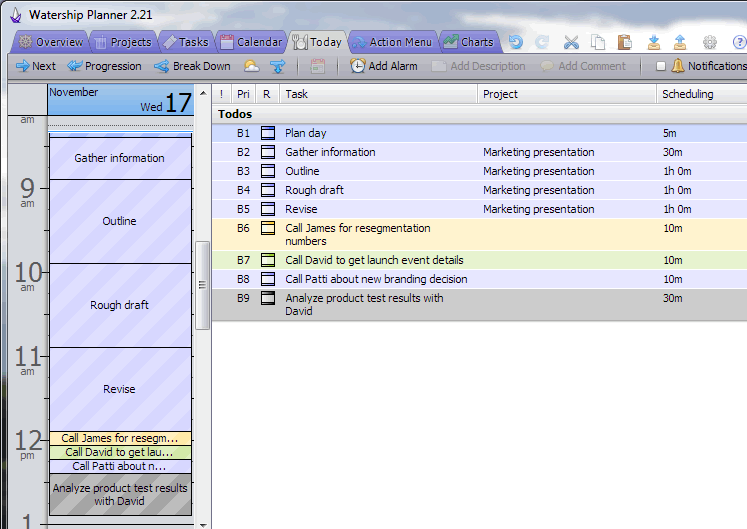
Jim then adds some breaks between the tasks. Some people like to add the breaks into the task estimates directly, so it shown together as one task. Jim likes having a separate color for breaks, and by having the breaks associated with a different role he can then see the time he spends on breaks using the Daily Report. He also adds lunch:
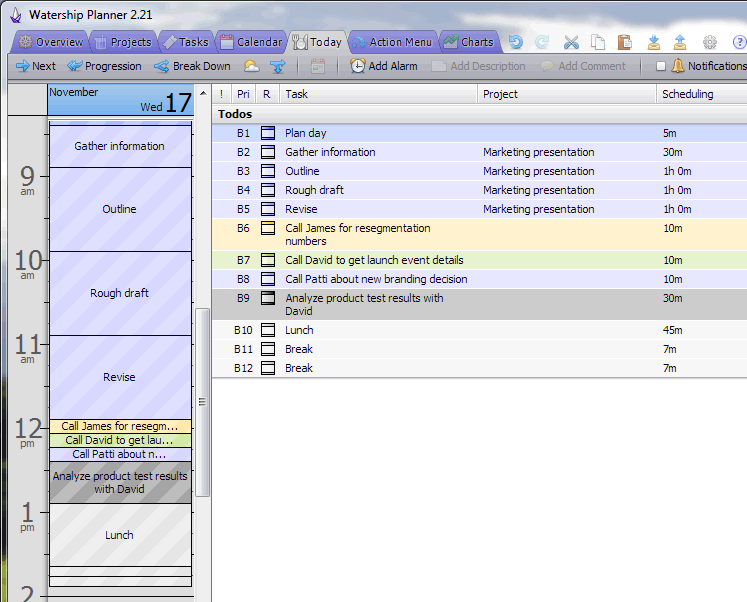
Only notice that the lunch and breaks are all bunched up at the end of the Schedule View. This is because tasks are mapped onto the Schedule View based on priority—if no constraints are broken. We will get to constraints soon, but first Jim needs to reprioritize his tasks to make the schedule look like he expects.
Setting Priorities
We left the lunch and breaks at the end of the Schedule View, from around 1pm to 2pm. To change a task's priority Jim drags the task into the position he wants. Jim wants a break after he finishes gathering information for his marketing presentation, so he drags it after that task in the Task List:
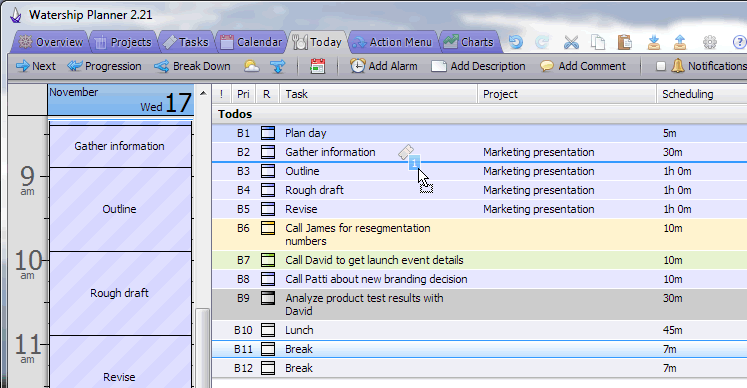
Jim drags the other breaks after his writing sessions, and schedules the lunch after the rough draft. Now his schedule looks better:
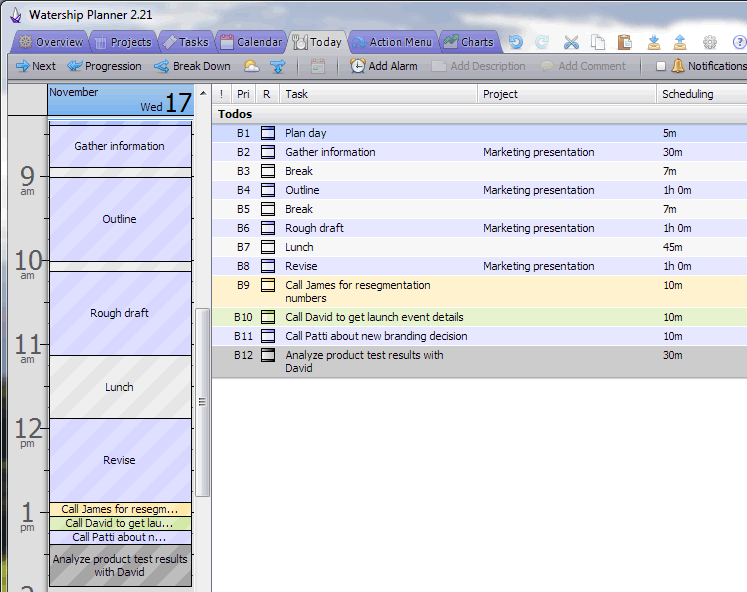
Creating Appointments
Jim also has a meeting with Alex at 12:15pm. We make these types of tasks with fixed start times appointments so that time mapping will know not to move them around your schedule on you. Instead, todos will be mapped around them in the way they fit best. Jim begins by selecting a range for the appointment in the Schedule View:

Notice that the selection goes over any mapped todos. Since these are todos without a fixed start time, they will move out of the way once the appointment is created. Jim creates an appointment from the selection by typing out the appointment:

Now the tasks in the Schedule View have reorganized themselves around the appointment. There was no longer time for the "revise" task to fit between lunch and the new appointment, so it was pushed off for later when there was enough time. But this left a gap between lunch and the new appointment. So time mapping ran down that day's task list looking for the first todo that would fit into this gap. Once it found the "call James" task it mapped it after the "lunch" task. But it still had another smaller gap left over after that, and so it kept looking to see if another task would fit. It found the "call David" task and squeezed that in there.
Jim also adds the appointment for the marketing presentation at 2pm:
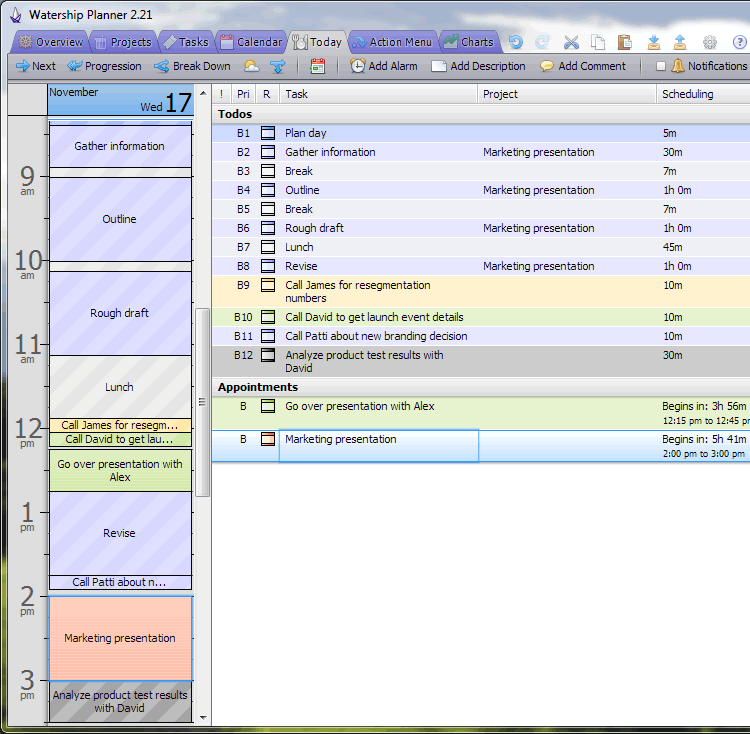
Now Jim has a complete map of his time. If David asks him when he thinks he will have time to meet with him, he can look at the schedule and estimate that he will be ready at 3pm. If things change, he can know up to hours ahead of time that he isn't going to make that time, and give David an early heads up.
Last Minute Change
Taking one last quick look, Jim notices that the phone call to James is happening before the meeting with Alex. That doesn't feel right to him, and he realizes that he needs to make the other calls before he can call James.
He drags the phone call with James after the other calls:
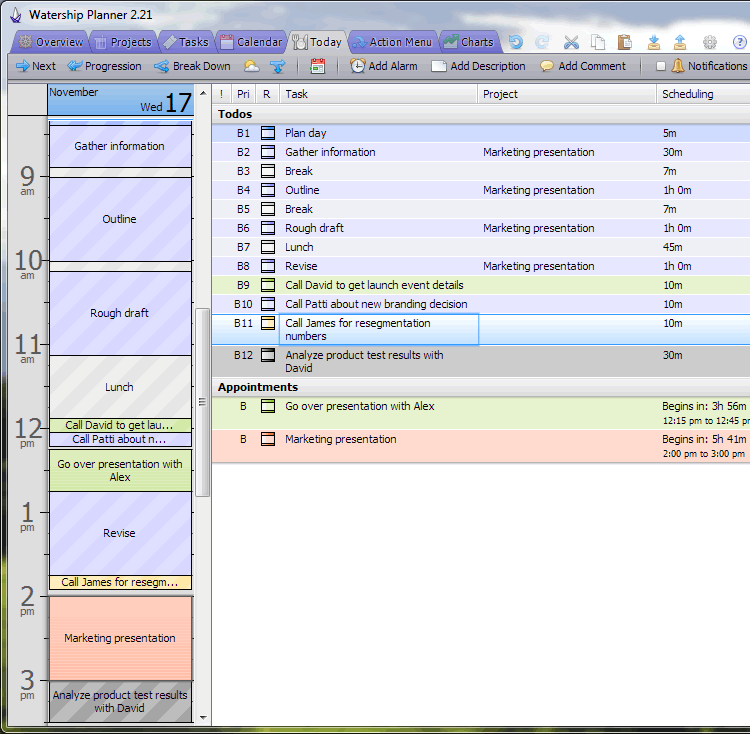
Jim uses these conflicts between what his schedule looks like in the Schedule View and how he feels it should look. If it doesn't look right, he can check the priorities he has set in the Task List to find the spots where he isn't clear on what is most important, or on what should go first. Sometimes he realizes that the priorities in the program are wrong, and changes them. Sometimes he realizes that the program was right and he had mixed up with the priorities in his head.
Jim finds that it is easier to look at his schedule and figure out if his todo list feels right or unrealistic. He can then begin to make these hard choices up front while he still has room to move, instead of realizing near the end of the day that he can't get it all done without giving up quality.
Starting the First Task
In preparing for battle I have always found that plans are useless, but planning is indispensable. Dwight D. Eisenhower
Now that Jim has sketched out his day, he begins by clicking the Next button. This marks the currently timed task as completed and begins a timer on the next task:
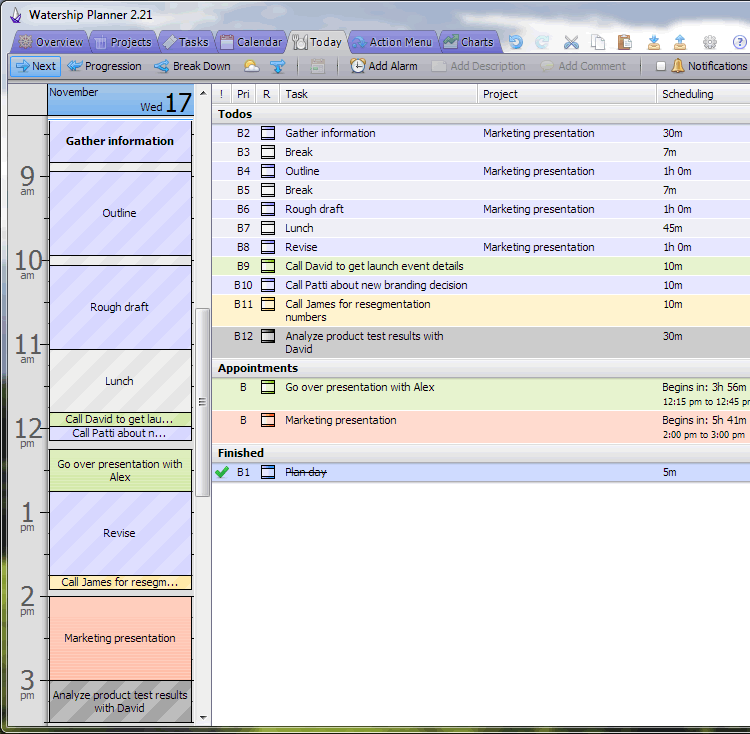
Now Jim minimizes Watership Planner and gets to work.
Any time Jim finds that his mind has wandered, and that he needs to redirect his focus back on the current task that he is working on, he brings up the Clapperboard to refresh his memory of where he was.
Jim hits the global hotkey Win + ; to bring up the Clapperboard from inside any program:
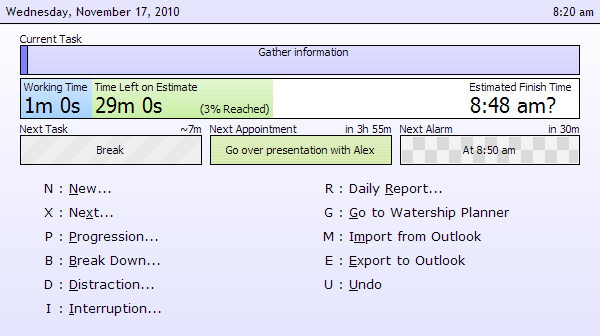
From here, Jim sees what the currently timed task is, the next alarm, and the next upcoming appointment. This is usually enough to jolt him back on track when his mind begins to wander.
Jim finds this helpful. His attention wanders, but he has a set habit that brings his attention back to the present task at hand.
Jim realizes that just making one better decision a day about his time increases how effective he is. That it isn't so much about consistently being more productive, it is just about saving him from one wrong decision that sends him down a path where he loses time on a low value task.
Before when he was working from a todo list, whenever he didn't know what he should be doing, he'd pick something from the list to do. Usually something easy because completing things feels good, and it makes the list shorter which feels like progress.
But now those same decisions feel different to him, because he can envision the schedule that they will create, and they don't feel that good to him anymore. He has learned to think in terms not of getting things accomplished, but it making the most of the time he has by putting in the effort into big projects that have a bigger impact.
Working from the Clapperboard Jim ensures that he is working on the most important thing that he can be doing with his time at that moment.
Staying Focused on Big Vague Tasks
So far, Jim is cruising and hasn't run into any problems. It is still early, so things are quiet. However, he knows that he needs to structure his rough draft or he could spend too much time focusing on a narrow train of thought while writing it and end up without enough time to finish the other parts that are just as important.
What Jim wants to do is lower the complexity of the current task. He knows that he wants to get a rough draft in an hour, but he doesn't quite know what to focus on. Jim could jump in and let this unfold in his head, but he knows that is risky.
Instead, what he needs is another list of tasks that makes up the "rough draft" task. This is done by "breaking down" the task.
Jim clicks the Break Down button:

Now Jim is presented with a Task List that will make up the tasks associated with the "rough draft" task:
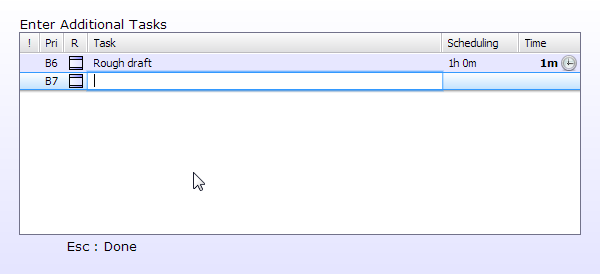
Jim then jots down different topics that he needs to cover for his presentation and puts them in the order he wants to write them:
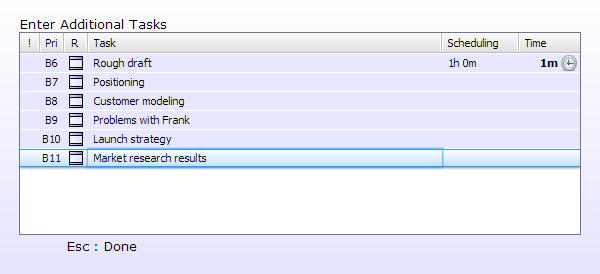
The Task List allows the same editing features as other Task Lists such as the one in the Day Tab. Jim selects the tasks he just created and gives them all an estimate of 10m:

Jim finishes up by reducing the estimate of the "rough draft" task to 5m, since the task was really just used to break itself down:
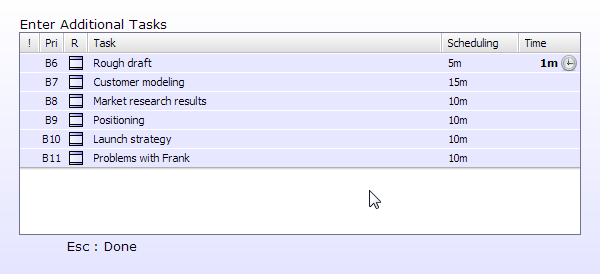
Now Jim has many smaller tasks that make up the "rough draft" task:
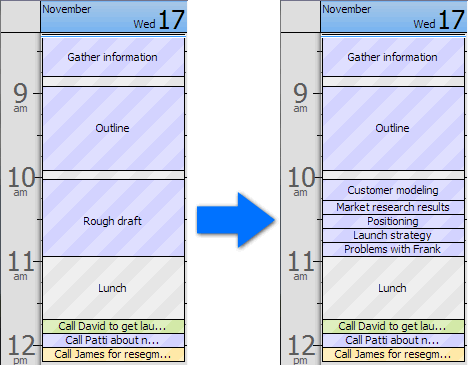
From here, Jim gets his first subtask under way by using the Next command.
Now Jim's attention isn't split between the low-level details of what he is writing, and the high-level orientation of making sure he is pacing himself to get all the things he wants to say included and doesn't spend to long on any one area. Instead, he has set a trail of smaller tasks for him to fill in, one by one. When he is working on any single subtask, like the next subtask "customer modeling", he only has to keep in mind that task, and its estimate—he can forget everything else. Since each task has its own estimate, they do the job of pacing Jim so that he doesn't spend too much time on any one area.
Jim finds that breaking down tasks into separate ideas means he no longer needs to keep as much in his working memory, allowing him the mental silence to get deep with the ideas about the actual topics.
It may not seem like much, but the different between a couple of items that you don't have to think about is kind of like the different between remembering a four-digit number: 1782, and a seven-digit number: 1877516. Jim gets more done by making it easier for him to think.
Finishing Early
Now Jim is really banging on all cylinders with the presentation material—he's already finishing up the "outline" task. Checking the Clapperboard he realizes that he is ahead of schedule by 20 minutes.
He sees this by reading the Time Left on Estimate:
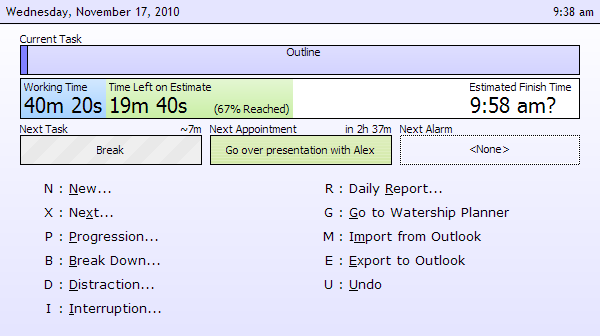
Jim then hits X in the Clapperboard for the Next command. This marks the currently timed task as completed. Watership Planner then adjusts the schedule to fill in the extra space now available to stay current with what is happening:
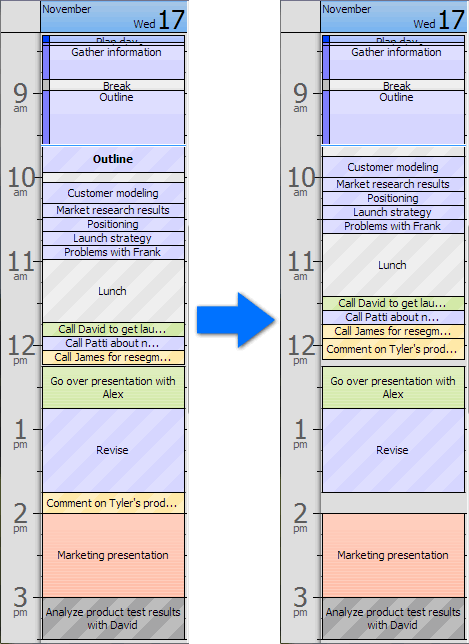
Getting Interrupted
Now Jim is 5m into his 2nd writing task when he gets an important flagged E-mail from another project group he was involved with last week. They are stuck without some additional details needed from him. Jim would like to get them the information needed to unblock them, but he knows that the marketing presentation is more important right now.
However, Jim has a habit set to help him stay focused on what really matters in situations like these. He adds the task in the Day Tab and bumps the priority to see what it does to his schedule as if he had decided to take the interruption:
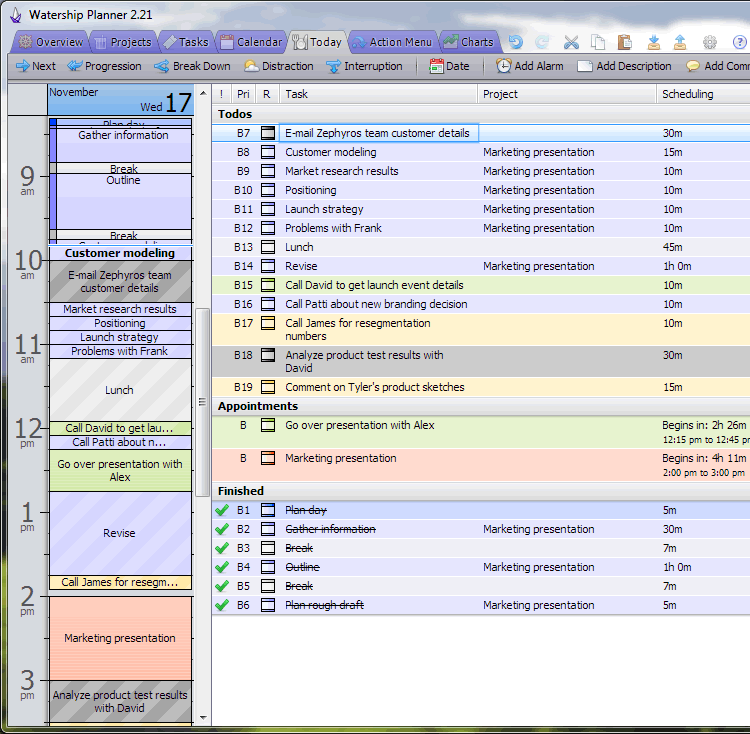
This causes his schedule to look like this:
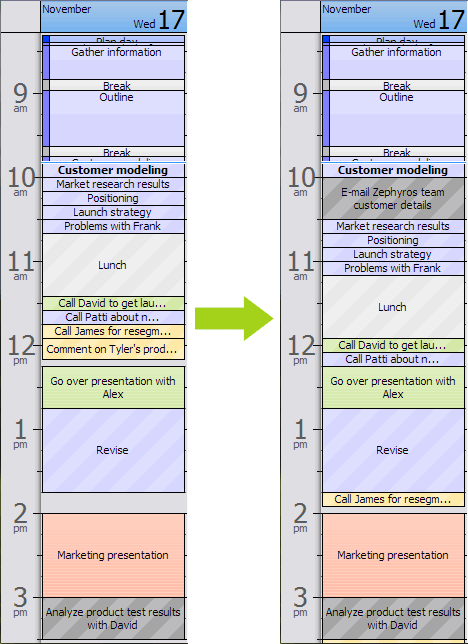
Now Jim can follow the consequences of taking that path. If it causes any schedule conflicts, they would pop up immediately and he would know that he doesn't have the time to take on the interruption.
Seeing visually what an interruption would do to his schedule gives Jim one last chance at making a better decision that he won't regret later.
In this case, if the "comment on Tyler's product sketches" task is required for the marketing presentation, then he can see from the schedule that he won't be able to make all of this fit in time for the meeting. He can tell because that task has been pushed to 3:30pm, after the "analyze product test results with David" task, and after the marketing presentation:
If changing priorities doesn't cause any conflicts with his schedule, Jim can take the interruption—giving it his entire focus knowing his is in the clear schedule wise until he finishes, or a scheduling constraint comes up.
Jim can also set an alarm to keep him on track. But even if he didn't set an alarm, if he works long enough to put any scheduling constraints at risk, Watership Planner will warn him when he is in danger of not being able to meet the constraints of his schedule:

Constraints are used to give Jim flexibility in his schedule. He can rearrange things or take interruptions knowing that he won't put himself in an impossible situation later because he has constraints set that will warn him when they are broken. With the flexibility of tasks rearranging themselves to fit the current situation, constraints are the safety net that these changes don't push something else outside its limits.
At any moment Jim can choose to break all his plans and Watership Planner will keep up with what Jim is actually doing, not what has been planned.
In this case, doing the interruption now would put the preparation needed for the meeting at risk, so Jim chooses not to take the interruption right now. Jim lowers the priority to where it doesn't come before the preparation work. Also since this is a task that he can work on in pieces here and there, when he has a chance, he makes the task Splittable by right clicking on the task to get the Context Menu:
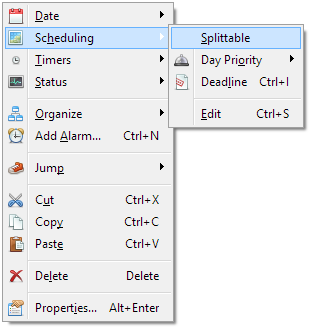
Now he can take advantage of the tiny gaps between tasks and appointments, where most unsplittable tasks can't fit:
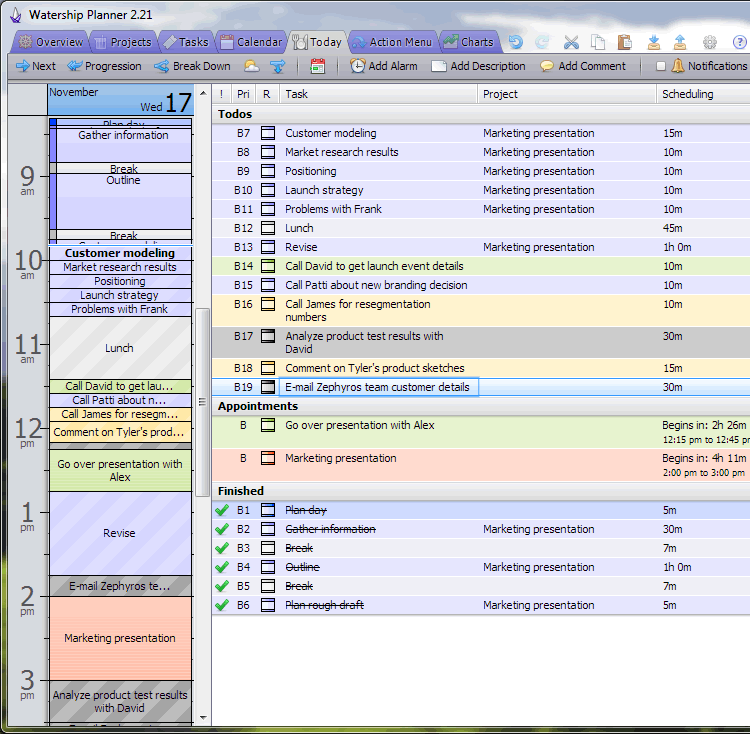
Satisfied with the new schedule, Jim sends a quick E-mail with an estimate of when he can get the numbers to unblock them, so that they can plan around it.
Getting Distracted
Now that the day is unfolding, the lawlessness of this town is showing itself.
Jim is working when he gets an urgent E-mail that he had to take care of right away—something even more important than the meeting. He could have started an interruption using the Clapperboard as soon as he realized that he was going to have to take the E-mail. But the E-mail aroused in him such a strong sense of urgency that he forgot.
So now that the E-mail is addressed, Jim assigns the time spent on the urgent E-mail as a distraction. This will readjust the estimate of the currently timed task left running all this time by cutting out the time spent on the distraction task.
Jim uses Win + ; to open the Clapperboard and hits D to enter the Distraction Menu. From here, he estimates that he spent 12m on it, which he calculated from the current timer of the current task. He knew that he started the E-mail about 4m into the writing task, so with the timer at 16m, he estimates that he spent 12m on the E-mail.
Jim enters 12m for the amount of time distracted:

The Distraction Menu then asks what the distraction was. If the distraction was a task that was already assigned to today's Task List, he could have selected it directly. Instead, Jim writes E-mail Cornell Division to have a new task created for him:
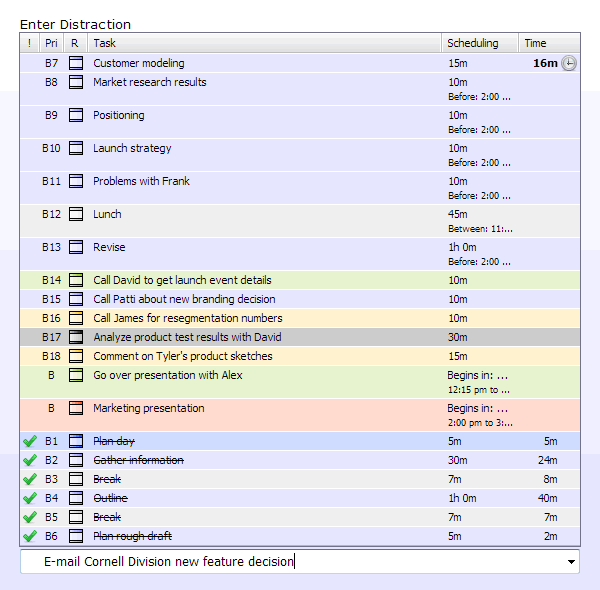
The Distraction command cuts out the duration from now until 12m ago as a tracked time and assigns it to the distraction task, marks it as completed, and sets the timer back to the task you were working on before the distraction. It is easier to understand what it does by seeing what happened to the schedule:
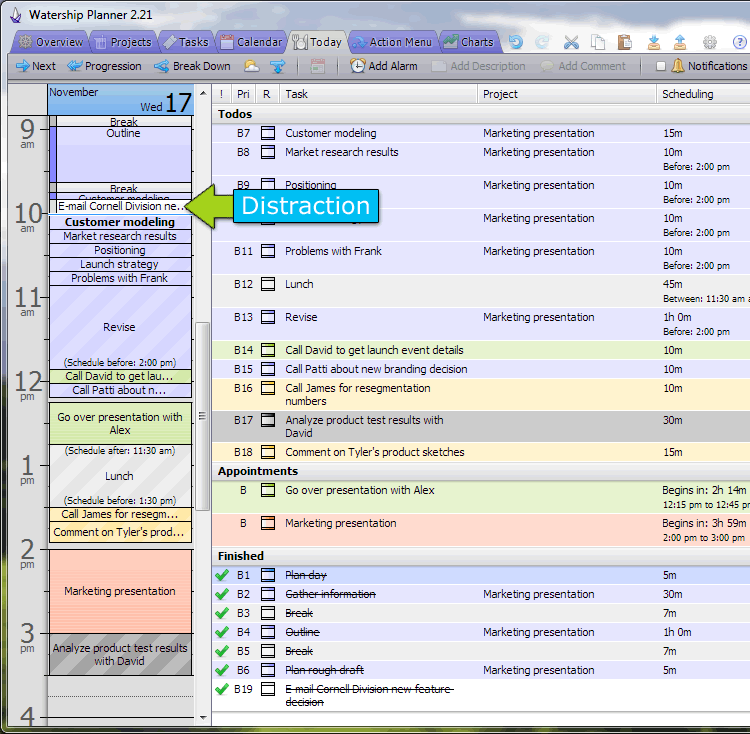
The currently timed task is still the previous task "customer modeling", but with the distraction time cut out of it, or 12m less in this case. This way the estimate on it is still valid, and Jim can keep track of where his time is going when he reviews his day in the evening and what his distractions were.
Making it Easy to Pick Up Where You Left Off
As Jim is writing, he is keeping a good pace by committing to 30m of focused writing, and then taking a short 5m break—to get another tea, to do some office stretches to keep his tennis game tip top, or to eat some almonds.
To create a quick alarm, Jim opens the Clapperboard using the Win + ; hotkey:
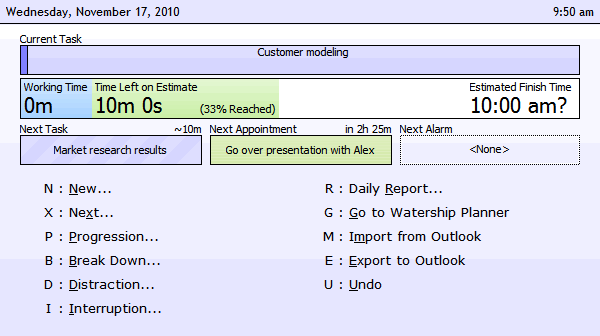
Then Jim enters the New Menu by hitting N:

Then Jim enters the New Alarm Menu by hitting A:
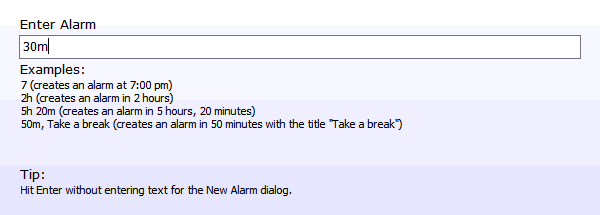
From here, Jim enters 30m for an alarm to go off in half an hour. So the entire combination is: Win + ;, na30m.
Jim thinks of this as: Clapperboard → New Alarm: in 30m.
But the menus are there for if he forgets.
Jim can also set an alarm to automatically go off whenever he starts a timer on a task and that timer then reaches 30m. So a repeating alarm that goes off every time you work on the associated task for 30m. This can be helpful for break-like tasks, so you are automatically reminded of when to start the next task. Or for pacing larger tasks that should be worked on in cycles of focus and breaks.
To set up one of these alarms he hits Enter at the New Alarm Menu to get the New Alarm Dialog:
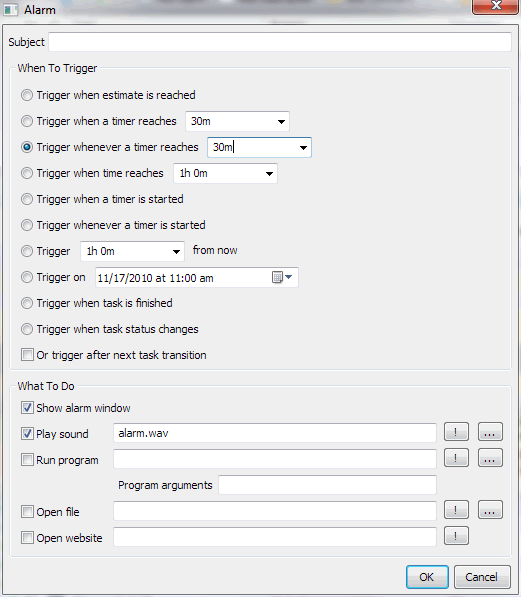
When an alarm goes off, Jim suppresses any urge to keep going and finish the idea that he's on. He knows that the stronger the urge is when he cuts away, the easier it will be to come back to continue later. So instead he keeps typing until he gets to the middle of a sentence—right in the middle of an idea—and then breaks away from the computer for a break. By cutting in the middle of an idea, he leaves a hook for him pick up again later.
This is like when you are walking toward the kitchen, but on the way there you realize you forgot why you were going to the kitchen, but you kept going anyways because you figured once you got there you would realize what you needed to do. When you got to the kitchen, you'd look around trying to connect things you see with the purpose of your trip. Sometimes you'd see the tea pot and remember: "right! I came for a screwdriver to fix the timer for proper tea brewing." Other times you would look and it wouldn't work, you'd still be drawing blank. Then you'd go back to the study, see the spread of tacos and then that would work: "right! I need lime for these bad boys."
So when Jim comes back and rereads the last sentence that he wrote, he will be jolted back into the state he was in when he wrote it. It will be easy for him to remember all the things going on in his mind as he was writing it, and he'll remember what he was going to write. This side steps the resistance we can feel when starting a task because we don't know exactly what the next step is, and so we are mentally wandering around grabbing at ideas trying to find the insight that will show us the way, like scanning the counters for clues. Instead, by writing out something easy that he already had planned Jim picks up momentum again quickly.
Cognitive scientists call this the Zeigarnik Effect—after Bluma Zeigarnik first noticed in a restaurant in Vienna that the waiter could remember what everyone at a table ordered without writing it down, but quickly forgot as soon as the table left. We tend to forget things once they reach closure either by making a plan or by finishing the task1. Instead we are more likely to have on our minds things that are left incomplete, or on things that we still haven't decided on doing.
Usually the Zeigarnik Effect works against Jim and is why he keeps things out of his mind and in Watership Planner, so that he can forget about them until it is their turn to take his attention.
However, for deep thinking tasks, Jim wants to remember his ideas and have them in the back of his mind so that he can make more connections with these ideas throughout the day.
Instead, if Jim were to finish his thought, he corks off this great hook he had and it won't catch anything anymore when he goes to try to use it again when he comes back. When he completes something the Zeigarnik Effect doesn't help him. He will begin forgetting fast where he was with the task because as far as the mind is concerned—at least the mind in charge of keeping memories—what he was working on in the moment is finished. The mind will begin putting that information away.
To the mind the next part of a task is another task completely, and Jim has to figure out how to begin it. This is easy when Jim has just finished that last part, because everything is still fresh in his mind. But if he then leaves to do something else, when he comes back to the task, it will take him longer to remember what he was thinking when he last left off.
It can take some heavy thinking to discover what exactly needs to be done, and what is next. Have you ever been interrupted while you were doing something difficult, and when you came back it took you a while just to figure out where you were and what you were working on? There was no bookmark for you, you probably got interrupted at a point where you had everything in memory, but didn't know exactly what was next.
Just by Jim making it a little bit easier to pick up working on a task, he prevents these transition points between tasks from becoming bigger distractions. The mind is most susceptible to distractions during these transitions. Not because Jim is lazy, but because when the mind is working to figure out what is next, it begins scanning all information looking for the right connection. The problem is, in this state Jim isn't very selective and can get caught up in just about anything.
Short Circuit Daydreaming
While Jim is writing out the rough draft for the marketing presentation, he comes up with a great idea that he wants to explore. He feels a surge of excitement because it could be really good. Only it is for an unrelated project. He knows that he can quickly work himself up thinking about these ideas to the point of losing half an hour in a trance. Knowing that this tendency in him limits his success, he has come up with a habit of logging all ideas and letting them incubate before exploring them more.
Jim brings up the Clapperboard, and hits N then T for the New Task Menu. Tasks entered like this will be added to the end of the day's task list. Jim types out his idea:

He logs anchor words—just enough to jolt him back into the state he was in when he had the idea, just like he would when leaving a bookmark. Later he can go through the ideas and prioritize them based on their impact towards his projects using ROI prioritization. That way he spends his time on the items he thinks of as most promising.
Either way, logging the idea is the fastest way to deflect the interruption of those thoughts. He could try to ignore the idea, but it will keep coming back to distract him, and he will have to use his limited mental energy to bring himself back to the current task. Energy that he needs to get a quality presentation ready on time. Why make it difficult for himself?
Jim knows that by following through with a single task at a time, he is able to make more progress with it, and he becomes trusted with more responsibility. The more he can manage himself, the more freedom he will get, and the more opportunities he will have in the future to lose himself in these ideas by solving harder and harder problems.
You can think of the difference between a concentrated state of mind and a busy state of mind as like the difference between how a dog thinks and how a lion thinks. A dog has a reactive mind and will drop whatever it is doing to chase a stick that is thrown their way. A lion has a focused mind that it uses to zero in on a zebra that it has detected as injured, concealed within a sea of disorienting black and white movement of all the others. It will block out everything but the zebra it is coming after.
Jim is able to concentrate and make consistent progress on meaningful projects that have a big impact because others don't have the techniques to sustain generating consistent thoughts towards a single project. There is too much information coming in and Jim knows that if he reacts to it, he won't make much of an impact in any project. He needs to get deep to find the breakthroughs that will advance the project—putting in more hours of reactive busy work doesn't differentiate him from everyone else that is doing the same thing.
To keep his thoughts on a single project when stuck, he does what many creative people do to silent his mind to keep it empty and available for new ideas. If an idea comes that doesn't pertain to the current task, he logs it and forgets about it—keeping his mind clear for the next idea. He keeps patiently doing this, gently letting thoughts come to him until he finds one that he wants to focus on. Through this process, he then gets an idea for the current task at hand—just as exhilarating as the other ideas and constructive towards the project that is most important at this moment.
Staying in Flow
If he feels resistance, he knows he can break the task down and then focus on a smaller piece with less details to think about.
If he is bored, he can think about raising the challenge level to get himself more engaged. Or he can jump to the project and refresh himself on "why" he is doing it in the first place, and focus on the end result.
By working with the flow commands, he is becoming more aware of this process of his concentration.
Unexpected Meeting
Kelly—Jim's boss—calls for a quick unexpected meeting in 15m. Before this would upset Jim, who would have his carefully planned schedule scrambled in front of him. Why even try? It made him feel like someone came in with muddy boots, followed by wet shaggy dogs on long leashes, into the living room that is his schedule.
But Kelly has noticed that lately Jim seems much more flexible—and yet at any point he can give a list of what he is working on, and their priority. When she interrupts him, she finds that she doesn't unload work on him because he always calculates what it would push out, and it causes them to both realize that the interruption wasn't as important as it first appeared. Instead, she gives it to one of Jim's coworkers.
Jim opens Watership Planner the easy way by bringing up the Clapperboard and then hitting G for Go to Watership Planner. Jim selects the appointment time on the Schedule View and sets the title and role:
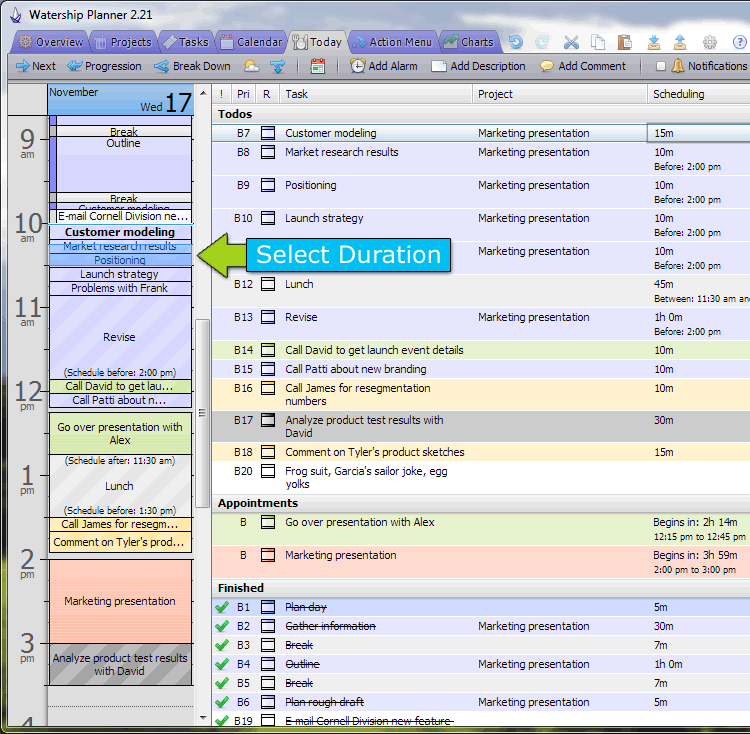
Jim's schedule is then automatically shuffled around to accommodate the new appointment. If this caused any scheduling constraints to be broken, he would alerted. Jim takes a look at the new schedule:
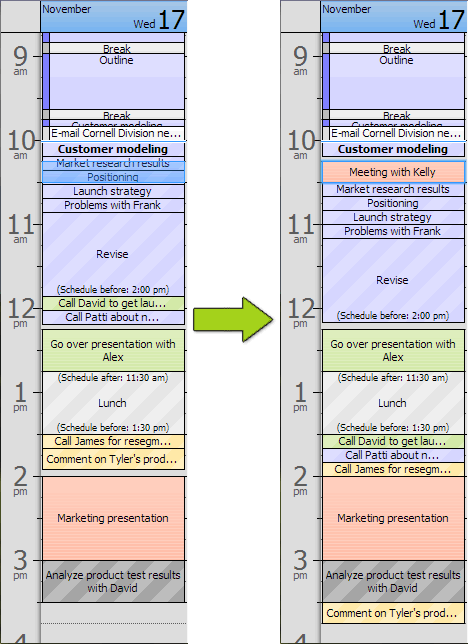
Try Watership Planner for Free
Make better decisions with your time, and experience the clarity of always having perspective.
Start Free Trial









































